Exploring Nepal
Chitwan, Pokhara and the Imperial Cities in the Kathmandu Valley
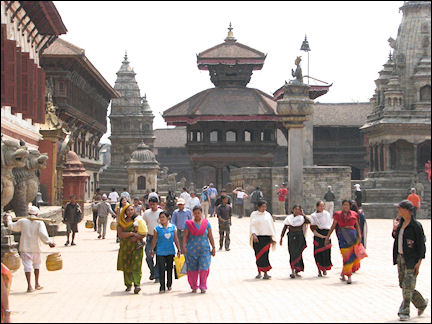
|
Nepal is more than the white peaks of the Himalayas. Chitwan National Park even has a subtropical climate and is perfect for a safari, for example on elephant back. Pokhara, starting point for trekking in the Annapurna region, lies on Lake Phewa and has plenty sports options for an active vacation. In the Kathmandu Valley are the imperial cities of Kathmandu, Patan and Bhaktapur, where culture lovers will get their hearts' desire.
Travelogue & photos: Hetty Dirksen
It's busy at the border between India and Nepal. The crossing is in a wide street with shops, restaurants and hotels. We get off the bus and take our leave of the driver and his mate who drove us all over India.
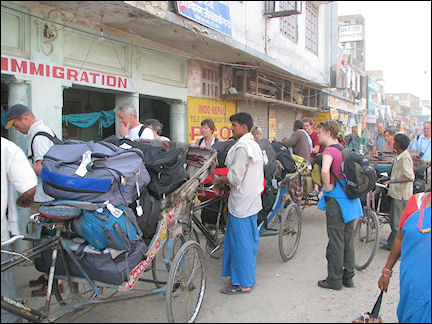
|
Our luggage is transferred onto waiting rickshaws and we walk in line to the Indian immigration service. We have to fill out a form and receive stamps in our passports. We cross the border into a piece of no-man's land.
At the Nepalese immigration service we also have to fill out forms and in return receive another stamp in our passports. Without further checks we cross the border into Nepal, where our bus is waiting. Our luggage is strapped to the roof and there we go, into Nepal.
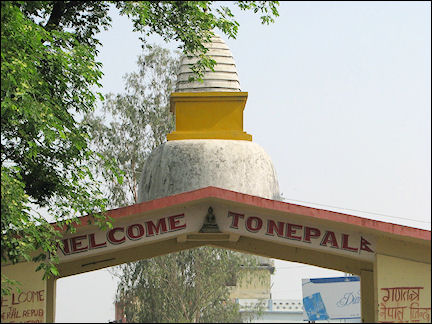
|
The landscape looks different immediately: greener and more mountains. The Nepalese consider the latter just hills: they have the Himalayas, only those are real mountains! After an hour we stop at a lively restaurant that serves a delicious noodle soup.
We arrive at the Rino Lodge in Sauraha, on the edge of the Chitwan National Park, at 3 PM.
Chitwan National Park
A jungle safari on elephant back
First we get some sleep and then we enjoy the peace and quiet of the park outside our lodge. The lodge has a beautiful garden, and if you sit still for a while, you see all kinds of beautifully colored birds, or birds with extremely long tails, it's all very exotic. I take some pictures of a cameleon who sits very still on a tree trunk.
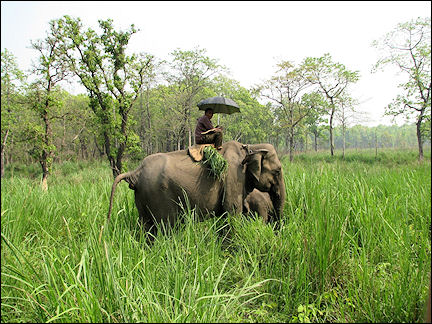
|
At 10 AM we walk to the river. Elephants are washed there in the morning and we are told that if we dare, we can sit on the backs of elephants who go into the river, an experience I am really looking forward to.
"My" elephant is already waiting for me by the river. The owner gives her the command to lie down so I can climb on her back. As soon as I sit behind her ears, she stands up, my goodness what a height! When the owner shouts at the elephant in Nepalese, a language I don't understand, and hits her with sticks, I panic and only want to get off her back.
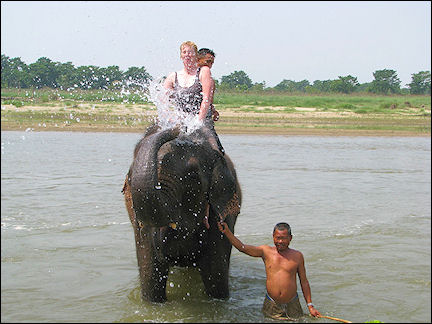
|
Once I'm with both feet on the ground, I understand the man was keeping the elephant from using its trunk to blow sand over her head, as I was sitting there and would have been sandblasted. I ask a cook from the restaurant where we had dinner yesterday to accompany me and give me instructions when necessary.
Together we climb on the elephant's back and as soon as she stands we walk to the river. This is great! When we're in the water, the elephant sprays water over her back and me. Not once, but again and again. I am soaked, but feel wonderful. The elephant lies down in the river and I glide off her back, climb back on and when she gets up again, she happily resumes spraying me. Once back on the bank, she slowly kneels and I get off.
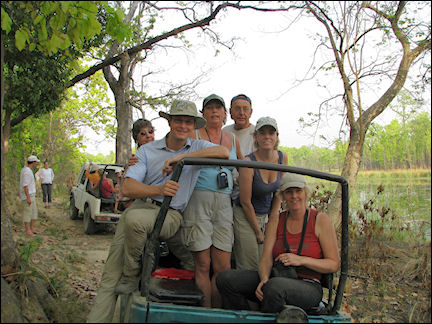
|
In the afternoon I go on a jeep safari. One person in the front next to the driver, six in the back in an open carrier and the guide sits on the roof of the cabin. The jungle here is dry and soon we're all grey with dust. I tuck my camera away (otherwise it would be destroyed) and only take it out when we stand still.
On the way we see buffalo from a distance and even a rhino between the elephant grass. After a few hours we stop at a crocodile farm. They breed crocs that are later returned to nature.
A little farther lies a tiger in a kind of corral, a ten by ten meters space, surrounded by 4 meters high poles. We can see him through the cracks. It is a beautiful animal with a sad history: he is four years old and has lived in captivity almost all his life. His mother killed people and fed her cubs with them. This animal is the only survivor, but because he tasted human flesh, it is too dangerous to let him live in freedom. They are working on a larger accomodation, but our guide couldn't tell us when it would be ready.
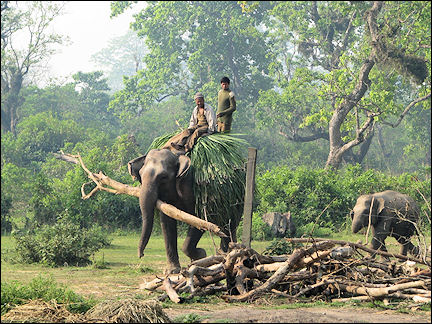
|
There are some tigers in Chitwan National Park but you're not likely to see them. On the way back we see paw prints of a tiger on our path, but the tiger itself is nowhere to be seen. At 5:30 PM we are back at our lodge, completely covered in dust.
In the evening we have dinner all together at KC, a lively restaurant next to our lodge. Angela has arranged for us to cook meals together with the cooks, tomorrow at 11 AM. We are curious to find out how things work in the kitchen of a Nepalese restaurant.
The next morning we leave at 7 AM for the Elephant Breeding Centre, one of the largest of its kind in Asia. When we arrive, an elephant just returns from the jungles with a load of elephant grass on her back.
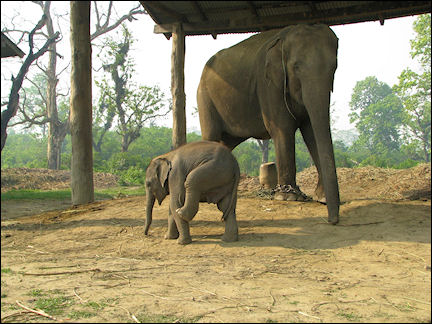
|
Elephants eat it all day long and it is also made into some kind of candy: it is made into bowls, in which some kind of grain is dropped; then the "bowl" is folded and tied with the though grass. The elephants learn to do their work by being rewarded. A group of kids is busy all day making this candy.
Several older elephants have chains around one of their legs. The young ones roam free and approach you to see if you have a treat for them. Which is fun, but even a young elephant is very large. The youngest calf is almost three months old and cute to watch; we even pet it.
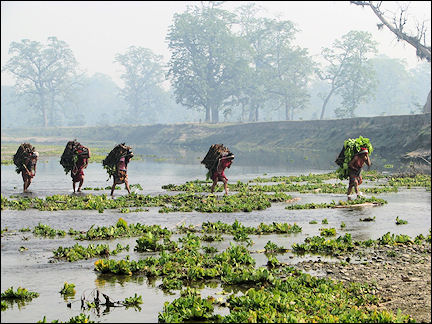
|
When we are back, Angela and I go to KC for our cooking lesson. At 11 PM five cooks arrive, who all will assist us. The owner explains what we are going to do exactly and we agree to prepare five different fish dishes, which we will eat for lunch with three of our travel companions.
There isn't a lot to do for us, because the cooks know exactly how to prepare everything, but we can ask whatever we want; we are mostly interested in the kinds of spices and herbs that are used. The food is ready at noon and when Carolien, Henk and Pieter arrive, we have lunch. The owner tells us exactly how everything is prepared, and Angela and I write down everything, we want to try this at home.
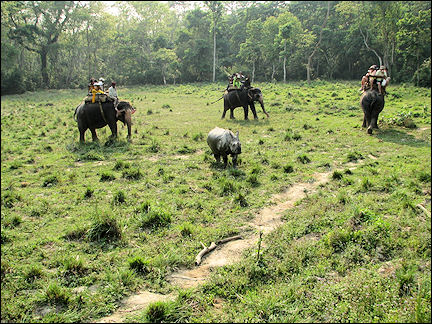
|
In the afternoon we take an elephant ride in the jungle. The four of us are squeezed into a carrier on the elephant's back. Not very comfortable, but the view is great. The elephant walk leisurely through the village into the jungle.
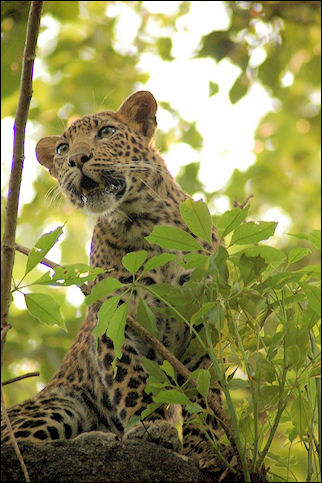
|
After a while we see a rhino. The rhinoceros just stands still while four elephants surround it. I understand that rhinoes can't see well, but have excellent smell; in this case, it only smells elephant, which it doesn't consider an enemy.
When we continue on, we see deer; it's amazing how close you can get to these animals when you're sitting on the back of an elephant. A little later we see a leopard on a tree branch, he is so incredibly beautiful.
The elephant walks below the branch, but the leopard doesn't move. Back at the lodge we hear that spotting a leopard is as unusual as seeing a tiger.
Pokhara
Rafting, mountain biking, mountain hiking and para-gliding
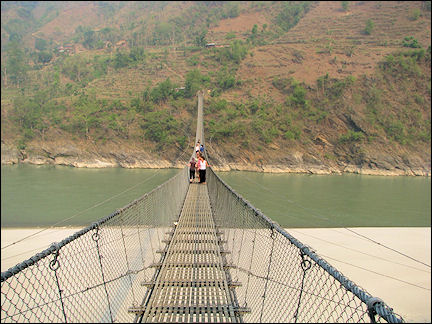
|
We leave for Pokhara early in the morning. The route is beautiful, along a river, which is suitable for rafting when the water level is higher. On the way we stop to take a look at a suspension bridge over the river. I walk onto it and see that it is secured to the rocks with long steel cables so it hardly wobbles.
We arrive in Pokhara at 1 PM. Pokhara lies on the shore of Lake Phewa and has many options for excursions and sports. Lots of different nationalities here, all sports lovers who are here for mountain climbing or to take a mountain bike trip in the surroundings. There is a bike route to the village of Sarangkot and on the way you see Mt. Annapurna, which is over 8,000 meters high.
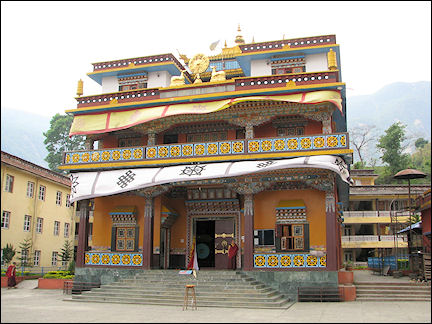
|
After checking in at Hotel View Point, we visit a temple with Tibetan monks in a Tibetan refugee camp. We arrive at the end of a service, when cookies and candy are distributed.
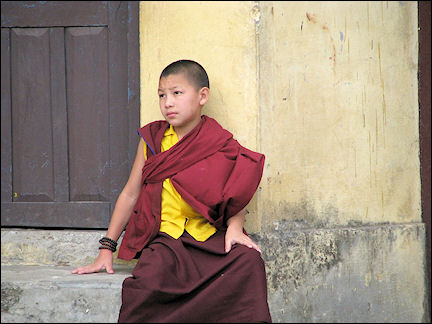
|
We can't understand a word, but it's interesting to see these monks, dressed in red, who have been fighting for years for a free Tibet.
In the evening we have dinner outside on the terrace of restaurant Boomerang near the water. There is live music and it's lively and crowded.
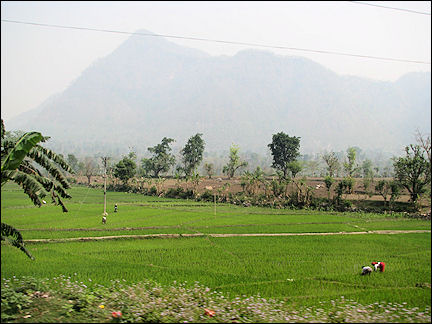
|
The next morning we get up at 4 AM to see Mt. Annapurna at sunrise. After an hour-long drive and a little hiking we arrive in ample time at the observation point. But unfortunately the sun stays hidden and we don't even get a glimpse of Mt. Annapurna. It is completely overcast, something that is often the case in this time of the year.
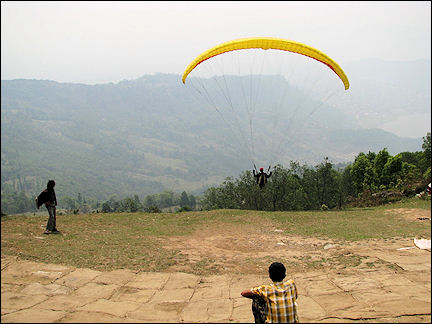
|
Back in Pokhara we have breakfast and then take a taxi to Mt. Sarangkot at an altitude of 1,450 meters. Carolien and Pieter are taking a para-gliding jump. I was planning on doing the same, but eventually I didn't, afraid to get air sick.
With other travel companions who joined us, we sit in the sun and wait until it's Carolien's and Pieter's turn. It's fun to watch them glide through the air. Maybe next time I shouldn't waste the opportunity.
Kathmandu Valley
The historic imperial cities of Kathmandu, Patan and Bhaktapur
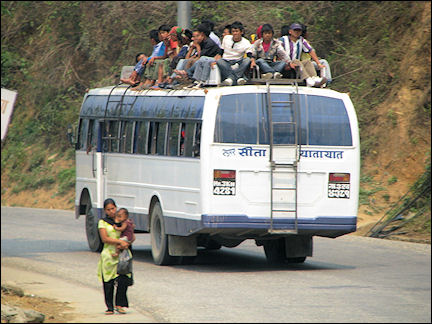
|
At 8 AM we leave for Kathmandu by bus. It's a distance of only 200 kilometers, but the mountain leg causes delays. On a narrow strip next to the road, at most three or four meters wide, people live in ramshackle huts. Children walk by the side of the road, where trucks pass in first gear, blowing their exhaust into the huts.
We reach Kathmandu in 6 hours and there we end up in a traffic jam, and thus it takes another hour befor we arrive at our hotel in the tourist district Thamel.
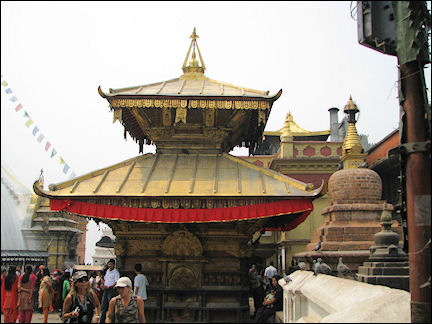
|
In the hotel I make a phone call to Ganga, a Nepalese friend, and we agree to meet tomorrow at 9 AM in the hotel. The receptionist explains how to get here, because Kathmandu doesn't have street names or house number. If you want to visit someone, you have to know in which district they live and ask for directions there. People are very curious and know everything about one another.
The next morning, Ganga's son Robbie takes her to my hotel on his motor bike. After a short conversation, we take our leave of Robbie and head into town.
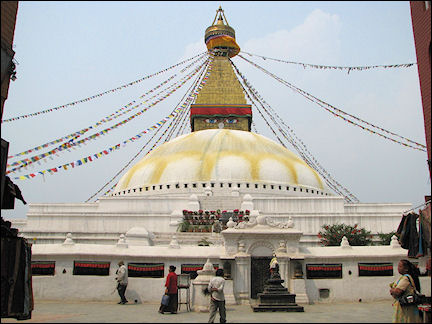
|
Ganga first takes me to the Buddhist stupa Swayambunath, aka Monkey Temple. We take a taxi which drives around the back; when we arrive on the hill I see the stupa with Buddha's eyes painted on them and lots of prayer flags.
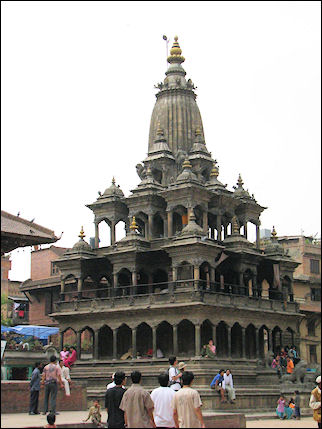
|
The Monkey Temple is the oldest temple in Nepal, over 2,500 years old. From the stupa you have a great view of the city, but unfortunately it's still too hazy in April and the view isn't worth a picture. After a while we leave, taking the stairs this time. We walk to Ganga's house, where I am introduced to her daughter in law and three grandchildren. They live on the two upper floors of a beautiful building and have a wonderful roof terrace with a view of the Monkey Temple.
After lunch we visit Patan, one of three imperial cities (Kathmandu, Patan and Bhaktapur, all three located in the Kathmandu Valley). I have to pay an entrance fee at the entrance of Patan, which is kind of an open-air museum. Patan is a beautiful city and very old, it is assumed that it dates from the third century BC. It attracts many tourists. We visit several temples and Ganga tells me a lot about the history of the place.
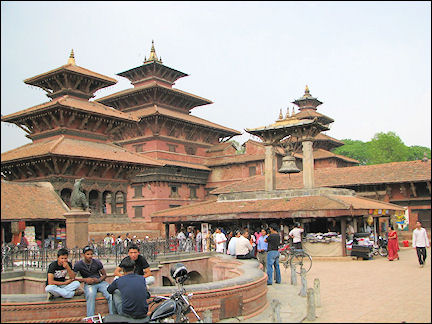
|
At the end of the afternoon we take a taxi to Durban Square in Kathmandu's old city center. There I meet some people who know my father very well. Ganga introduces me and everyone says I look like my father.
I buy souvenirs together with Ganga, which is a good idea: she knows the best stores and is much better in bargaining. At the market a boy, who also knows my father, gives me three necklaces for my children and a singing bowl. We have tea by his stall and I take a picture of the children, and they enjoy it. They laugh when they see themselves on the little display.
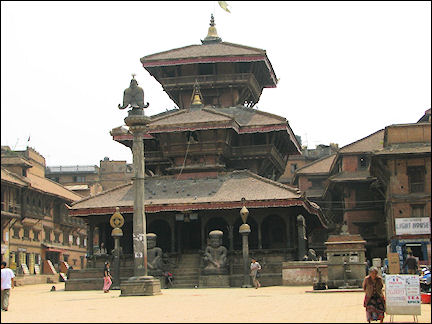
|
In the evening I have dinner in Ganga's apartment. Around 9:30 PM Robbie takes me back to the hotel on his motor bike. In Nepal, all motor bikes are 125 cc and just as in India, a helmet is only compulsory for the driver. So I sit on the back seat without a helmet; strangely, I like the idea of sitting on a motor bike in the dark, without helmet, riding around in a metropolis like Kathmandu.
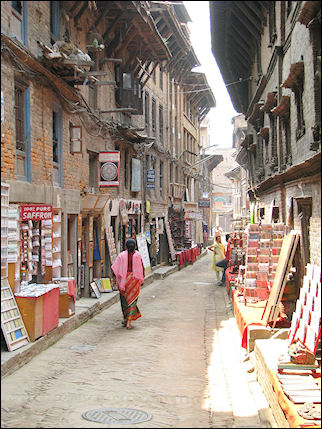
|
The next day I visit Bhaktapur with Ganga. This imperial city lies a little farther from Kathmandu but is really worth the trip. It is a magnificent old city with many beautiful buildings and temples. Ganga and I have sodas in an outdoor café. We talk about how she told me so much about her country's culture when she was in The Netherlands and that she now has the opportunity to show me everything.
In the afternoon we return to Kathmandu. Ganga takes me to the Hindu temple complex Pashupathinath on the holy Bagmathi river. Bodies are cremated here; the members of the royal family who were killed by crown prince Diprenda were also burned here in 2001.
When we arrive at the temple comlex, we sit down on the other side of the river and watch groups of people part with their loved ones. Ganga tells me about the ceremony; it is different from Varanasi in India, in the sense that children are cremated here and not just thrown in the river.
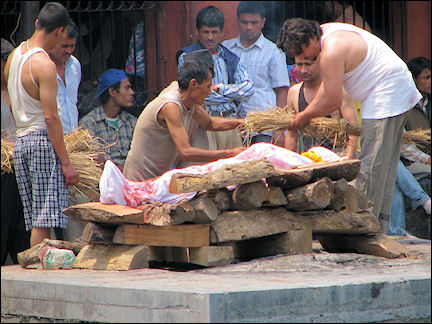
|
After a while we cross the river again and pass the pyres at close distance on our way to visit another part of the complex. People in white clothes are walking between the pyres. They stay here for two weeks to mourn. The mourning is concluded with a festival and then they return home to their families.
Behind the complex is an old people's home, something I suspect you don't see very often in Nepal. Ganga tells me that it costs a 1,000 rupies (about 10 euro) to live there, but it's only for people without family. She has a daughter who lives in Sweden, but Ganga still doesn't qualify for a room there.
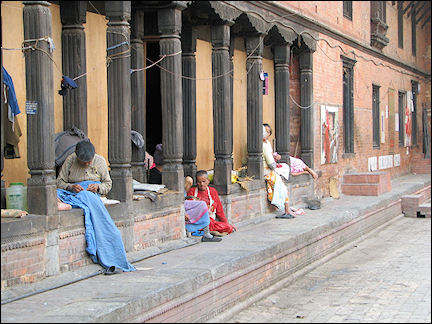
|
We take a taxi to the city center and visit the house of Kumari, the living goddess. It is a girl who appears in the window of her house several times a day, but we are out of luck.
We have a snack on a roof terrace and at the end of the afternoon Ganga goes home and I return to my hotel. In the evening we go out for dinner with the whole group. It is the last night of our trip, tomorrow the long trip home begins.
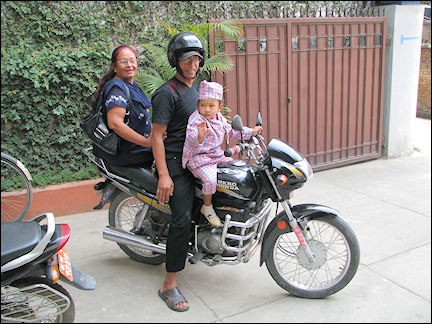
|
Ganga, Robbie and the little boy are in the hotel early next morning to say goodbye. Then we take the bus to the airport and fly via New Delhi and London back to Amsterdam.